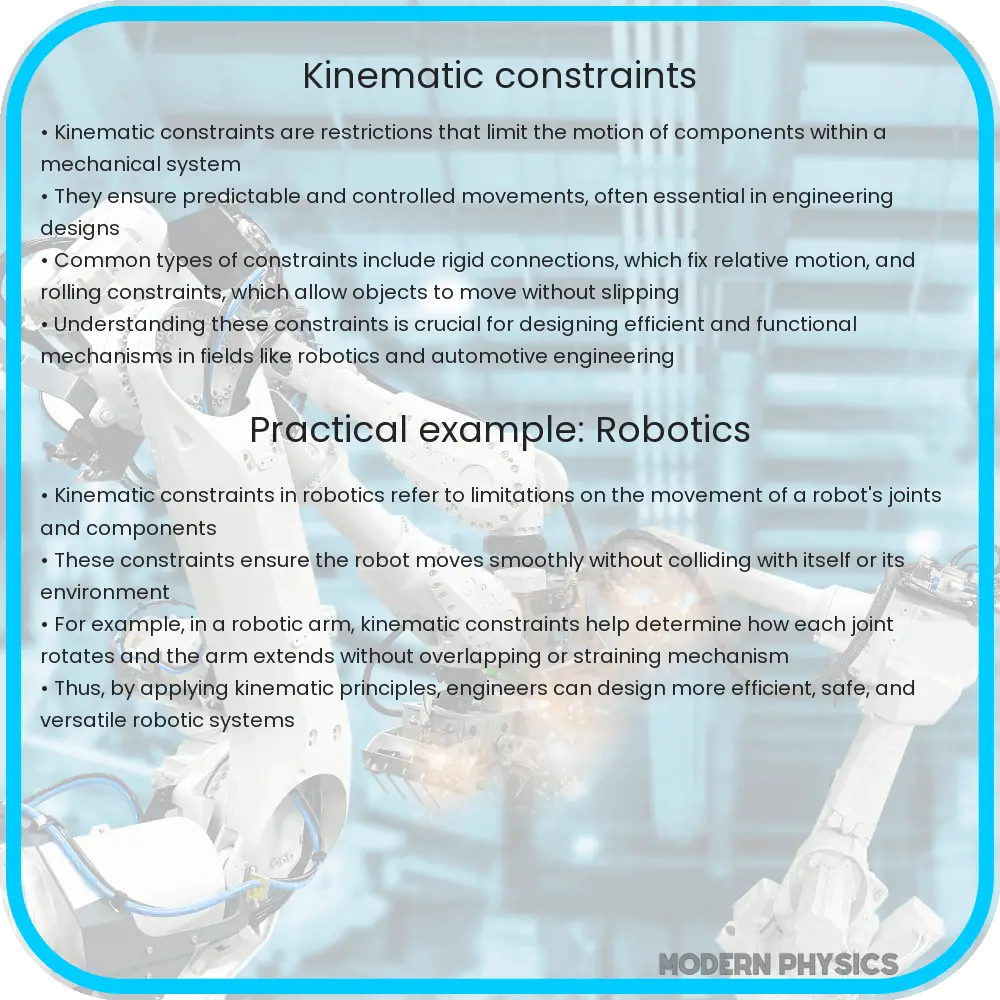Explore the role of kinematic constraints in mechanical design, optimization, and analysis, with insights into applications and future trends.

Kinematic Constraints in Optimization, Modeling, and Analysis
Kinematic constraints play a critical role in the field of mechanical engineering, particularly in the realms of optimization, modeling, and analysis. These constraints are fundamental in understanding and designing mechanisms and machinery that operate under specified conditions and limitations. In this context, kinematic constraints refer to the limitations or restrictions on the motion of components within a mechanical system.
Understanding Kinematic Constraints
At their core, kinematic constraints are conditions that define how parts of a mechanism are allowed to move relative to each other. They can be classified into two main categories:
- Holonomic Constraints: These are constraints that depend on the coordinates of the system and can be expressed in the form of equations relating these coordinates. For example, in a piston-cylinder arrangement, the linear motion of the piston is a holonomic constraint as it can be described using a linear equation.
- Non-Holonomic Constraints: These are constraints that are not integrable into positional constraints. They often involve inequalities or cannot be expressed purely in terms of coordinates. A common example is a rolling wheel which, while moving, must satisfy a non-holonomic constraint that its point of contact with the ground must have zero velocity relative to the ground.
Kinematic constraints are essential in the design and analysis of mechanisms. They help in determining the possible motions of a mechanism under given conditions and are crucial for the dynamic analysis of mechanical systems.
Role in Optimization and Analysis
In optimization and modeling, kinematic constraints are used to ensure that the designed mechanism adheres to desired motion patterns while also considering factors like efficiency, cost, and material constraints. For instance, in robotic arm design, kinematic constraints ensure that the arm reaches a desired position without violating physical limitations or colliding with surrounding objects.
Analysis of kinematic constraints involves both theoretical and computational approaches. Theoretical analysis often uses mathematical models to understand the implications of various constraints on a system’s motion. Computational methods, such as finite element analysis (FEA), provide a more detailed and practical approach, especially in complex systems. These analyses are crucial for predicting the behavior of a mechanism under various operating conditions, assessing wear and tear, and ensuring optimal performance.
Application of Kinematic Constraints in Various Fields
Kinematic constraints find applications in various engineering disciplines. In automotive engineering, they are vital in the design of steering mechanisms, ensuring that wheels turn correctly as per steering input while maintaining contact with the road. In aerospace, kinematic constraints help in the design of landing gear systems, where the motion of each component is precisely defined to ensure safe landing and take-off. Robotics extensively uses these constraints to design robots that perform complex tasks with high precision and reliability.
Challenges and Future Directions
One of the primary challenges in applying kinematic constraints lies in the complexity of modeling and analyzing systems with multiple moving parts. As systems become more intricate, the computational cost and complexity of analysis increase. Additionally, real-world imperfections and nonlinearities can complicate the application of theoretical models.
Future advancements in computational methods and the integration of AI and machine learning techniques are expected to significantly enhance the modeling and analysis of kinematic constraints. These technologies could provide more accurate predictions of system behavior, even in highly complex and nonlinear systems. Moreover, the development of more robust and versatile software tools will further simplify the process of incorporating kinematic constraints in design and analysis.
Conclusion
Kinematic constraints are indispensable in the field of mechanical engineering, serving as a cornerstone for the design, analysis, and optimization of various mechanical systems. They provide a framework for understanding and predicting the motion of components in a mechanism, ensuring that designs meet both functional and safety requirements. The application of these constraints spans multiple industries, from automotive to robotics, highlighting their universal importance. Despite the challenges posed by complex systems, ongoing advancements in computational tools and methodologies continue to push the boundaries of what can be achieved in mechanism design and analysis. As we move forward, the integration of more sophisticated technologies like AI will undoubtedly open new horizons in the application and understanding of kinematic constraints.
